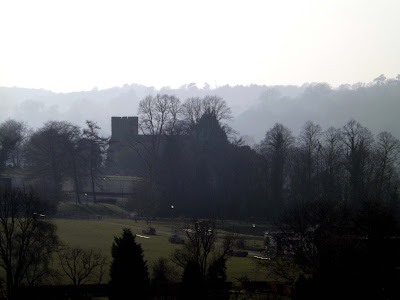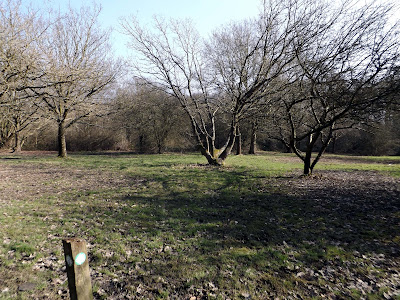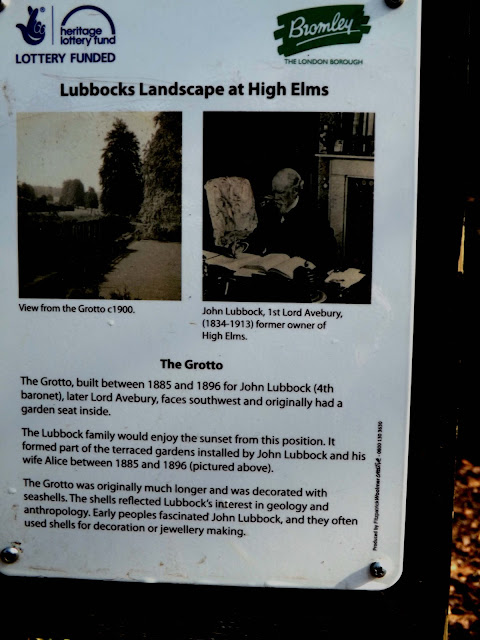On Monday the 4th of
March 2013 I left home to travel to Petts Wood Station to complete
the London Loop Section 3 Jubilee Park to West Wickham Common.
I arrived after almost 2 hours traveling by bus, tube and
train and exit Petts Wood Station crossing the bridge and out by some shops.
I eventually come to enter Jubilee Park, the path skirts along the edge of the park on very
muddy paths.
I exited the park for more walking along some streets before
coming to Crofton Wood.
It appears this Woodland is up for auction for £30,000.
I emerge on a road in Crofton
Almost opposite the village sign is a path that
leads on a path beside garden fences. At the end of this I cross Lovibonds Road and follow another road up before turning left into
Darrick Wood.
I emerge out on a hilltop with overlooking views south out to suburbia .I take the middle of the three paths down the hill and cross the A21.
I take the footpath opposite between houses, out onto Gladstone
Road before entering Farnborough village.
The village name derives from Fearnbiorginga, meaning village among the ferns on the hill.
Farnborough was once the first stop out of London
along the coach road down to Tonbridge and Hastings.
The village evolved on the main road from London to Hastings which originally ran via Church Road and Old Hill (to the south of the village).
I walk along Church Road and up a raised path through a lych gate into the church of
St Giles the Abbott. The church stands high on the hill and
the flint nave was rebuilt in the 1640s after storm damage
At about the same time they rebuilt the Nave they planted
the huge Yew tree by the west door.
I have now entered
High Elms Estate. Out of the woods I cross a lane and take a path opposite
through a car park and pass a picnic area in High Elms Estate.
I stopped off in the café here to grab something to eat
before continuing.
This grand 400 acre estate has been owned by Bromley council
since 1965.It was formerly the country home of the Lubbock
family. Their classic Italian style mansion was burnt down and all that remains
is the stable block and the Eton Fives court.
 |
| Eton Fives Court |
This game was originally played against the walls of Eton
College Chapel, where two players waxing aggressive with a hard ball. The rules
required three playing surfaces. The game was popular for a while, this was one
of the earliest courts dating back to 1840.
Sir John William Lubbock the second planted the grounds with
specimen trees from around the world that I can see around me.
I walk through what remains of the country home and its
gardens and grotto.
I walk downhill along a path that leads out into the car
park of a golf club and exit into a lane. I cross the road to the path
opposite. The path follows the edge of
an old orchard. I see an old weather boarded tower
of Clockhouse Farm. The bell in the
tower was rung in Victorian times to tell farm workers when their lunch break
started and finished.
Opposite the tower I climb a hill over a golf course and see
more wild parakeets that I’ve seen on previous sections of this walk.
The path drops down to a lane past a field of horses.
I walk along the lane for a short distance
before turning right onto an ancient hedge greenway called Bogey Lane.
This leads out onto Farthing Street, where I saw and heard two Kestrels in an old oak.
Amazing sight and sound. I walk down the road into Shire Lane where I cross and take a path that skirts along the
lane.
To my right I can see Holwood House, with a long
frontage with Grecian portico.The house was designed by Decimus Burton, built between 1823 and 1826 and is in the Greek Revival style.
I take another path that climbs up beside a gate that
displays a Met police sign “Police Dogs in training”.
As I climbed the hill I saw another kestrel hovering over
the fields.
The path brings me to a clearing where stands what’s left of
The Wilberforce Oak.
Here in 1788 William Wilberforce discussed with the Younger WilliamPitt (Prime minister and the owner of
Holwood) to resolve on a parliamentary bill to abolish the slave trade. They
met beneath the oak where today only a
stump remains. In 1862 the stone bench that is fenced off was placed here to
commemorate the occasion.
There are fine views across the Vale of Keston. I sat and
rested for a while ,drank some water before continuing.
The path drops down to a road, which I cross and enter onto
Keston Common. I follow a path where I drop down to Caesars Well. The spring
here bubbling up from its brick lined circle of pebbles, is the source of theRavensbourne.
As there is an Iron age fort above on the hill, this clear water was clearly used before Caesars time. The water flows into Keston ponds,made in the early 19th century to provide Holwood house with clear water.
I cross the road into the woods past another
pond to my right and follow the path till I emerge out onto a road up to TheFox Public house at Keston
I cross the main road at the roundabout into West Common road and left onto another track through a wooded area and past several delightful houses
 |
| Church seen on my last walk. |
I emerge by the Corporation of London sign, where on the
rear was a long list of bye-laws where it seems you can’t do much at all!
I now cross the road back into Polecat alley where I started
my last walk back to Hayes Rail station.
Altogether about a 10 mile walk and again without getting lost! Must be getting the hang of this!






































































No comments:
Post a Comment